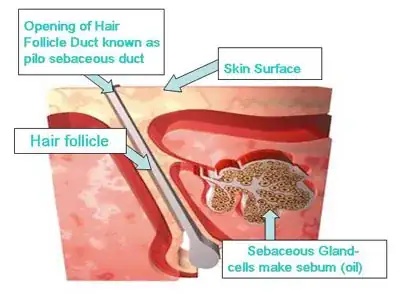I have the combination skin. Skin becomes visibly red after threading the upper lips. What is the way to get rid of the redness that appears on the skin immediately after threading the upper lips?
1 Answers
I've actually had to look up this procedure first. From what I've read in this article the procedure itself seems sanitary.
Still our skin surface contains bacteria. When the hair is removed, the bacteria can enter through the pilo-sebaceuous duct.

Image source: http://www.aknicare.co.uk/science.php
This is why it would be good to disinfect the skin prior to the procedure. The choice of antiseptic will depend on your skin sensitivity. 70% ethanol is a very effective antiseptic, but if you have sensitive skin (and the area above the mouth is sensitive in its own right) then ethanol can cause irritation.
Another, somewhat milder antiseptic is boric acid, but if it is absorbed and has systemic effects it can be toxic. This is why its use in cosmetic products has been restricted in the UK. (Martindale: The Complete Drug Reference, 34th edition) This is why (if you chose to use it) it should be used on intact skin only. (An aside: The use in children under 3 years of age is now forbidden. This is because children have more permeable skin, and absorption is more likely than in adults.)
You can always ask your pharmacist or dermatologist to recommend you an antiseptic that would be good for you to use on this sensitive area.
After the procedure you can use a bit of talc powder to lessen the irritation.
From Martindale: The Complete Drug Reference:
Purified talc is used in massage and as a dusting powder to allay irritation and prevent chafing. It is usually mixed with starch, to increase absorption of moisture, and zinc oxide. Talc used in dusting powders or as talc poudrage should be sterilised.
Inhalation of talc can cause respiratory irritation; prolonged exposure may produce pneumoconiosis.
Because the area is right under your nose, you should just be careful not to inhale talc when you apply it, and you can apply a thin layer (there is no need for a thick layer). The microbiological quality of talc powder is very important, so make sure to purchase a reliable brand.
-
Because the redness occurs immediately after plucking, I'm tempted to believe it has little to do with infection, but perhaps a lot to do with a mild local inflammatory response? Or can infection appear that quickly? I've not looked into it. Your answer is interesting! I'll be curious to know if it helps the OP. :) – anongoodnurse Jul 18 '15 at 01:26
-
1Thanks @anongoodnurse ! The first part of the response is based on anecdotal knowledge (actually from ladies who wax this area - that prior disinfection reduces the redness, so I hoped it might translate to this procedure) and my own logic. My guess would be that it is a mild local inflammatory response, but that local inflammation is somewhat enhanced in the presence of bacteria. Talc should soothe the irritation after any sort of hair removal - shaving, waxing or tweezing, and since the process of threading is similar to tweezing it should apply to that as well. – Lucky Jul 18 '15 at 03:36